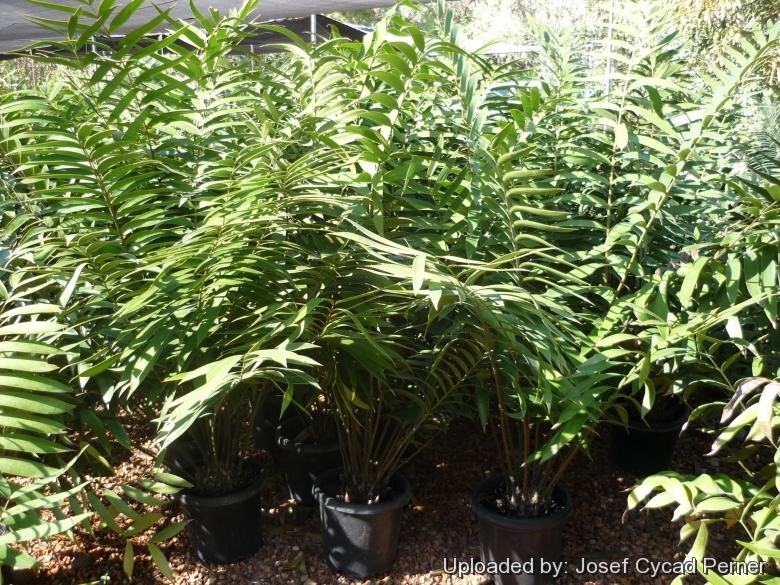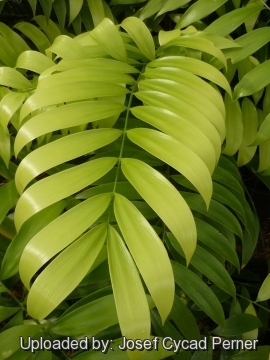




Your support is critical to our success.
Tijdschr. Wis- Natuurk. Wetensch. Eerste Kl. Kon. Ned. Inst. Wetensch. 1: 42 (1848)
Family: ZAMIACEAE

Habit at Cycad International, Katherine, Northern Territory, Australia.
Origin and Habitat: The genus Ceratozamia contains 16-18 currently living species and one or two fossil species. Most species are endemic to mountainous areas of Mexico, while Ceratozamia robustaSN|30191]]SN|30191]] extends into the mountains of Guatemala and Belize. However, local experts believe that there are at least six to seven taxa currently identified as Ceratozamia robustaSN|30191]]SN|30191]]. Most of the populations are small with less than 30 plants.
Habitat and Ecology: Plants occur as an understorey plant in evergreen wet, humid tropical forests. Usually in limestone areas on steep slopes and cliffs. Though it is distributed in various localities within the Mexican states of Veracruz, Oaxaca, and Chiapas as well as Guatemala and Belize, nearly all of the populations show continued declines, almost entirely due to habitat destruction (clearing) and fires. Moreover many specimens have been collected in the past for ornamental purposes.
Synonyms:
- Ceratozamia robusta Miq.
- Ceratozamia mexicana var. robusta (Miq.) Dyer
Ceratozamia robusta Miq.
Tijdschr. Wis- Natuurk. Wetensch. Eerste Kl. Kon. Ned. Inst. Wetensch. 1: 42 (1848)
Synonymy: 6
- Ceratozamia robusta Miq.
- Ceratozamia mexicana var. robusta (Miq.) Dyer
- Ceratozamia intermedia Miq.
- Ceratozamia longifolia Miq.
- Ceratozamia mexicana var. longifolia (Miq.) Dyer
- Ceratozamia longifolia var. minor Miq.
SPANISH (Español): Costilla De León
Description: Ceratozamia robustaSN|30174]]SN|30191]] is the largest of the ceratozamias and can attain a spread of 5-6 or more metres with usually branched upright or procumbent stems up to 2 metres tall. On its top it carries a tuft consisting of long arcing fronds, that are spirally arranged and interspersed with cataphylls (Modified leaf, much reduced and thickened, serving to protect the apical meristem and produced in flushes preceding the emergence of cones or leaves). The individual plants are either all male or all female (dioecious). C. robusta is widely distributed over a large area and variations occur in leaflet width and length growth. The taxonomy of this taxon is uncertain and many subpopulations may in future be classified as separate species.
Derivation of specific name: Latin, robusta, large.
Distinguishing characters: C. robusta is a large palm-like plant with long leaves and thick wide leaflets with densely prickled petioles and the prickles are stout. Microsporophyll apex with prominent paired horn-like projections are also characteristic of this species and are placed in vertical rows in cones.
Stems: Partially subterranean, pachycaul, dark brown, erect, bent or procumbent up to 200 cm long, and up to 30 cm in diameter.
Roots: In this plant the coral-roots appear, as in Cycas, often in great numbers. Coralloid roots are special upwardly growing multi-branched roots where nitrogen is fixed in symbiosis with Nostoc and Anabena algae. They differ from the ordinary soil-roots by their forked branching.
Leaves (fronds): 5-35 in crown, pinnate, arching, 2-3 m long, flat (not keeled) in section, bright green, semiglossy, new growth emerging bronze, red or chocolate brown, or mid-green, smooth, and glabrous. Leaflets 50-200, simple, entire, not clustered, symmetric, broadest below middle, falcate, light green above, paler beneath, articulated, inserted near the edges of the rachis towards the adaxial side with numerous parallel veins and no distinct midrib. Blades lanceolate, coriaceous to almost papery, around 25-30 cm in length, 2.5-4(-5) cm wide, apex acute, the margins rolled back, lower leaflets not reduced to spines. Rachis not or slightly spirally twisted. Petioles 20-60 cm long, swollen and woolly at the base, densely prickled and the prickles are stout.
Pollen Cones: Cylindrical to conical, greenish to brown, 30-40(-50) cm long, 10-14 cm in diameter, microsporophylls 3-5 mm long, each with a pair of recurved horns. Peduncle c. 10 cm long, woolly.
Seed Cones: Ovoid-cylindrical, bluish-green (25-)30-40(-50) cm long, 10-15 cm wide, megasporophylls broadly exagonal, 3-3.5 cm long, each with a pair of recurved horns. Peduncle c 15 cm long, woolly. Female cone splits open at maturity.
Seeds: Ovoidal, 25(-30) mm long, 20 mm wide, creamy white becoming brown as they ages.
Note: C. robusta has been included with Ceratozamia mexicanaSN|30191]]SN|30174]] by some authorities but is much more vigorous with a larger trunk, longer leaves and cones and acute tips on the leaflets. Plants from the forests of Belize and Guatemala are the largest of all and often have crowns of relatively lax leaves. Those from Veracruz are smaller and less vigorous than other variants and those from Chiapas fall somewhere in between"
Bibliography: Major references and further lectures
1) V.P. Singh “Australia and Its Geography” Sarup & Sons, 2010
2) Karl Goebel “Organography of Plants: Special organography” Hafner Publishing Company, 1969
3) Gregory, T. & Chemnick, J. 2010. Ceratozamia robusta. The IUCN Red List of Threatened Species. Version 2014.3. <www.iucnredlist.org>. Downloaded on 17 January 2015.
4) Whitelock, Loran M., "The Cycads", Timber press, 2002
5) Haynes J.L, "World List of Cycads: A Historical Review", IUCN/SSC Cycad Specialist Group, 2011
6) Wikipedia contributors. "Ceratozamia robusta." Wikipedia, The Free Encyclopedia. Wikipedia, The Free Encyclopedia, 24 Jul. 2014. Web. 17 Jan. 2015.
7) Ken Hill: 1998-2010 "Ceratozamia robusta" – In The Cycad Pages. <http://plantnet.rbgsyd.nsw.gov.au/PlantNet/cycad/> Downloaded on 15 Jan. 2015.
8) Jones, David L. “Cycads of the world.” Australia: Reed Books. 1993.
9) Vovides, A.P., John D. Rees and Mario Vázquez-Torres. “Flora de Veracruz: Fascículo 26, Zamiaceae.” Xalapa, Veracruz: Instituto Nacional de Investigaciones sobre Recursos Bióticos.
10) Christopher J. Earle "Ceratozamia robusta" The Gymnosperm Database 2012-11-23 http://www.conifers.org Web. 17 Jan. 2015.

Emerging frond. Photo by: Josef Cycad Perner
The gallery now contains thousands of pictures, however it is possible to do even more. We are, of course, seeking photos of species not yet shown in the gallery but not only that, we are also looking for better pictures than those already present. Read More...
Cultivation and Propagation: Ceratozamia mexicanaSN|30174]]SN|30174]] is a palm-or fern-like plant with long pinnate, arching fronds, with new growth emerging pinkish or coppery green. It's a beauty and one of the best landscape plants in the genus. It prefers to be in the shade to look its best. It has proven to be quite cold hardy. It grows fairly fast and reacts well to fertilizer applications. Not common in cultivation but available at specialty nurseries.
Exposition: It prefers bright light exposure but colour bleaches when in full sun; best with some protection from afternoon heat but not in constant deep shade.
Soil: Needs a neutral, well drained sandy soil spot, with deep soil, but will still thrive in less than ideal conditions. Mulch with organic materials (bark or leaf mould).
Moisture: Water when dry. Drought tolerant.
Fertilization. Because of its growth habit, fertilize only when terminal bud begins to swell, indicating the start of the annual growth cycle.
Hardiness: It should be protected from extreme cold, but it is much hardier than you might think. (USDA Zones 9.-11) Sustains leaf damage at -2° C.
Maintenance: Minimal; removal of offsets if desired, removal of spent fronds
Use: Landscape as cultivated perennial in warm areas, it makes a great accent or specimen plant. Several can be planted together for a lush, tropical effect. Plant on three to five-foot-centers to create a mass planting. Use near the patio, in mixed foundation plantings or in perennial beds. It is a spectacular house-plant or interior-scape specimen in cool areas tough enough to survive occasional neglect and harsh indoor environments.
Warning: All parts of the plant are poisonous to animals and humans. The toxicity causes liver and kidney failure, as well as eventual paralysis. Dehydration sets in very quickly. No treatment for the poisoning is currently known. Poisonous Parts: Fleshy seeds, leaves. Protect pets and instruct children to never eat or chew any plant material without permission.
Propagation: Seeds. The germination process is very slow and difficult to achieve in cultivation, after fertile seeds are collected, they usually need several months of storage before the inner embryo is ready to germinate. Therefore, it is best to clean the seeds of external fruit and set them aside before attempting to propagate the seeds. Seeds should be sown in shallow container, lightly covered with sand, and after germination, potted off in small pots of moderately rich, light soil. The growing plants do best in partial shade. The old plants occasionally send up suckers around the base of the trunk. These may be taken off when in a dormant state and rooted, care being taken to remove the leaves to guard against excessive transpiration. The advantage of the "pups" is that you will know its sex, for seedlings you will have to wait several years until the plant flowers to find out.
| Your Actions | |
|---|---|
| Back to Ceratozamia index | |
| Back to Zamiaceae index | |
 |
Back to Palms And Cycads Encyclopedia index |
Privacy stantement - Terms and conditions - How to cite - About us - Feedback - Donate


